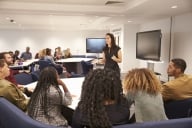You have /5 articles left.
Sign up for a free account or log in.
Last week, I was in Indianapolis co-teaching, with Jesse Stommel, a week-long course on Digital Pedagogy and Networked Learning at HILT 2015. I’ve attended a number of Digital Humanities summer institutes, both through HILT and DHSI, and I was really excited to participate on the other side of the proverbial fence. You can see the materials we read, discussed, created, and curated here (as a Google Doc) or here (as a Storify). You can also browse the entire archive of tweets that used the #hilt2015 hashtag.
Not only was it my first time as a one of the faculty, it was also the first time in my role as a faculty developer. Most of the workshops are taught by traditional faculty, graduate students, librarians, and digital humanities directors and “staff”, so I was a bit of an anomaly. But quickly it became apparent the intersections of duties, concerns, and skillsets that I shared with the other various instructors there who were also “staff” at their home institutions. There is more to be said about these intersections, particularly in regards to the “services” we are expected to provide, but for one week, we were all teachers and facilitators, sharing our experience and expertise.
Digital pedagogy is a challenging course to teach in this week-long format. The majority of workshops offered during these DH are focused on a clear set of skills or deliverables. And one way this course in interpreted is to be about digital tools in the classroom. But we wanted to take a step back from a week-long onslaught of tools and focus on those elements that lead to decide to use tools in the first place, as well as how to decide what tools are appropriate for whatever learning outcome or goal you have for the course or lesson.
Pair that with student-centered approach to the class, and it could seem a little disjointed at times for the participants. We wanted to challenge the participants to think about their pedagogy, as well as the affordances of the digital, in ways that perhaps they weren’t prepared for. Unlike a workshop on the coding language R, where most, if not all, the students would say their goal was to learn R, our students were confronted with an open-ended goal, guided by discussions about technology and pedagogy.
Not that we didn’t build anything, or learn any tools, but I know some students wanted to build assignments while others wanted hands-on tutorials with tools, while others wanted to build websites, and others still collect examples and syllabi. And so that’s what we did. But that kind of learning can be challenging, because it does break with traditional expectations around what a workshop is and how we teach.
(I had, as an aside, the exact same issue with the instructional technology graduate-level class I taught last winter. I’m still trying to balance giving them freedom to learn and experiment in ways that are relevant to them and their expectations.)
I’m aiming to be back at HILT next year, if they’ll have me, and perhaps I’ll take a page from the HILT workshop I took in 2014 on making games – each day, we make something, using a tool or technique discussed in the morning. The downside, of course, is that there are WAY more than four or five useful and relevant tools and approaches we could be using. Or perhaps I’ll use one of my 2015 colleagues’ class as an example, working together to build one thing that everyone can use.
These events always challenge me to think about my own imperfect and evolving pedagogy in ways that I don’t always expect, but always appreciate.





